Attached files
| file | filename |
|---|---|
| 8-K - 8-K - CAPITAL SENIOR LIVING CORP | d15315d8k.htm |
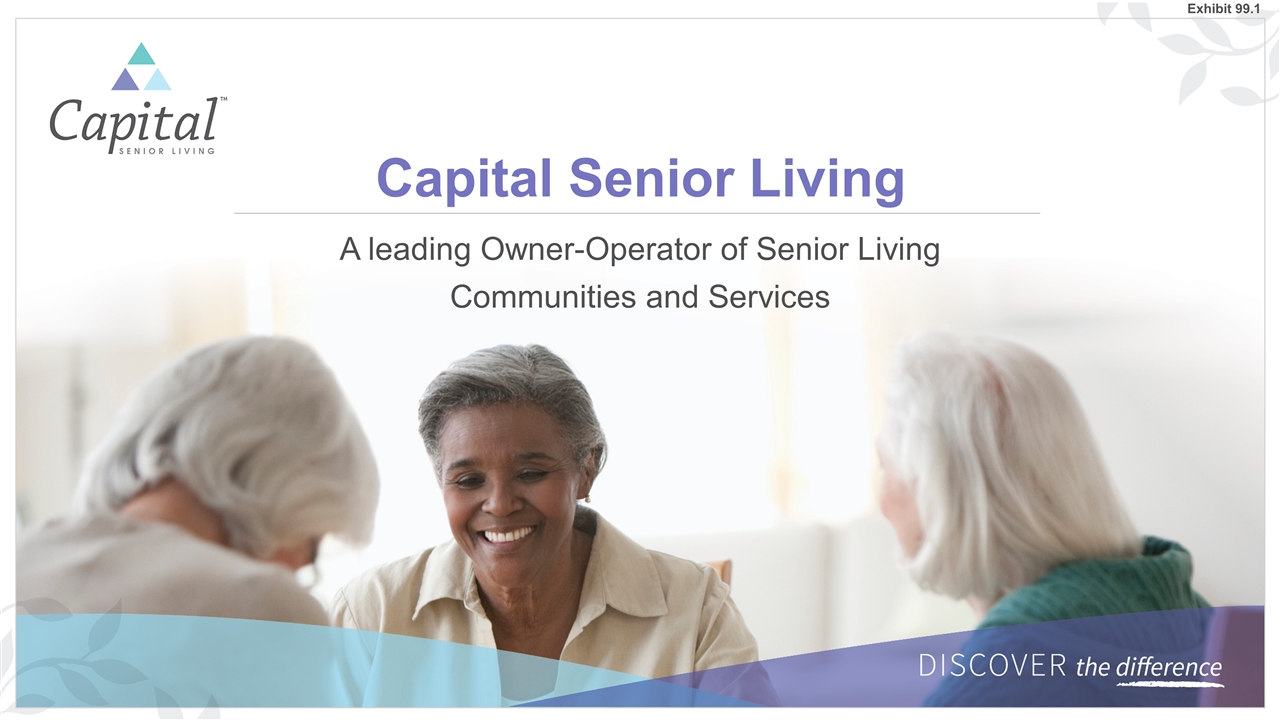
Capital Senior Living A leading Owner-Operator of Senior Living Communities and Services Exhibit 99.1
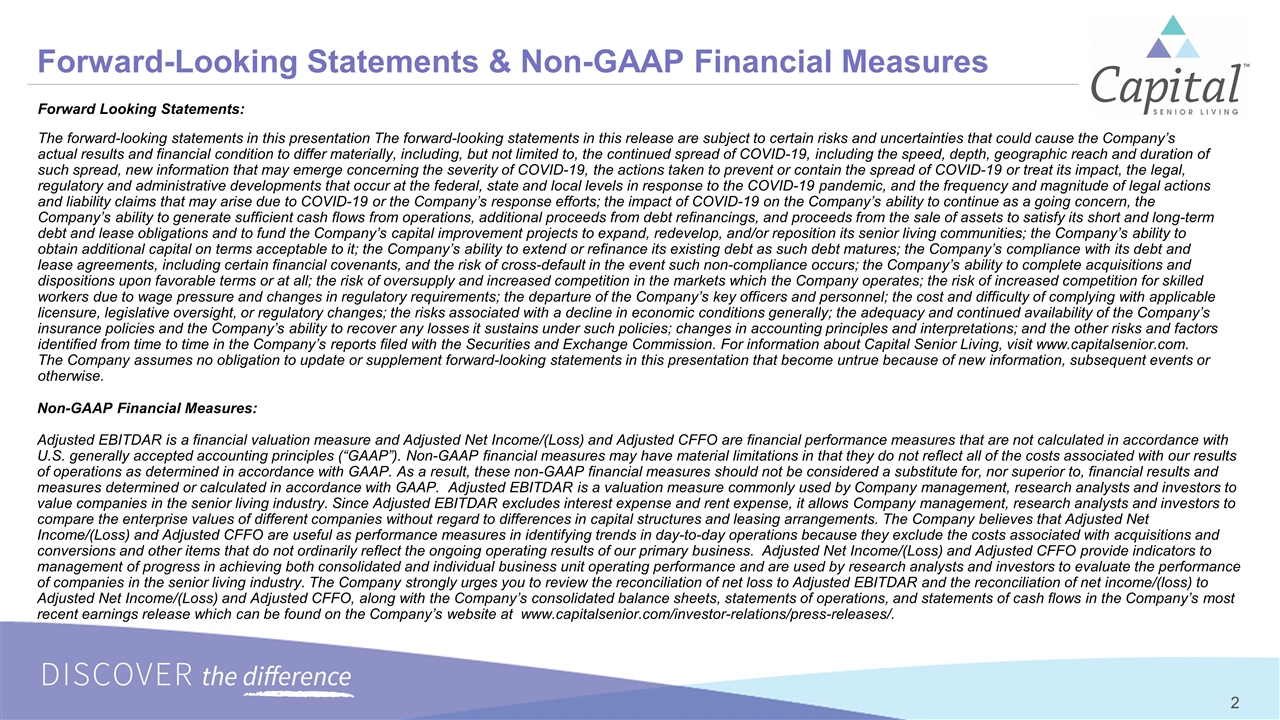
Forward-Looking Statements & Non-GAAP Financial Measures Forward Looking Statements: The forward-looking statements in this presentation The forward-looking statements in this release are subject to certain risks and uncertainties that could cause the Company’s actual results and financial condition to differ materially, including, but not limited to, the continued spread of COVID-19, including the speed, depth, geographic reach and duration of such spread, new information that may emerge concerning the severity of COVID-19, the actions taken to prevent or contain the spread of COVID-19 or treat its impact, the legal, regulatory and administrative developments that occur at the federal, state and local levels in response to the COVID-19 pandemic, and the frequency and magnitude of legal actions and liability claims that may arise due to COVID-19 or the Company’s response efforts; the impact of COVID-19 on the Company’s ability to continue as a going concern, the Company’s ability to generate sufficient cash flows from operations, additional proceeds from debt refinancings, and proceeds from the sale of assets to satisfy its short and long-term debt and lease obligations and to fund the Company’s capital improvement projects to expand, redevelop, and/or reposition its senior living communities; the Company’s ability to obtain additional capital on terms acceptable to it; the Company’s ability to extend or refinance its existing debt as such debt matures; the Company’s compliance with its debt and lease agreements, including certain financial covenants, and the risk of cross-default in the event such non-compliance occurs; the Company’s ability to complete acquisitions and dispositions upon favorable terms or at all; the risk of oversupply and increased competition in the markets which the Company operates; the risk of increased competition for skilled workers due to wage pressure and changes in regulatory requirements; the departure of the Company’s key officers and personnel; the cost and difficulty of complying with applicable licensure, legislative oversight, or regulatory changes; the risks associated with a decline in economic conditions generally; the adequacy and continued availability of the Company’s insurance policies and the Company’s ability to recover any losses it sustains under such policies; changes in accounting principles and interpretations; and the other risks and factors identified from time to time in the Company’s reports filed with the Securities and Exchange Commission. For information about Capital Senior Living, visit www.capitalsenior.com. The Company assumes no obligation to update or supplement forward-looking statements in this presentation that become untrue because of new information, subsequent events or otherwise. Non-GAAP Financial Measures: Adjusted EBITDAR is a financial valuation measure and Adjusted Net Income/(Loss) and Adjusted CFFO are financial performance measures that are not calculated in accordance with U.S. generally accepted accounting principles (“GAAP”). Non-GAAP financial measures may have material limitations in that they do not reflect all of the costs associated with our results of operations as determined in accordance with GAAP. As a result, these non-GAAP financial measures should not be considered a substitute for, nor superior to, financial results and measures determined or calculated in accordance with GAAP. Adjusted EBITDAR is a valuation measure commonly used by Company management, research analysts and investors to value companies in the senior living industry. Since Adjusted EBITDAR excludes interest expense and rent expense, it allows Company management, research analysts and investors to compare the enterprise values of different companies without regard to differences in capital structures and leasing arrangements. The Company believes that Adjusted Net Income/(Loss) and Adjusted CFFO are useful as performance measures in identifying trends in day-to-day operations because they exclude the costs associated with acquisitions and conversions and other items that do not ordinarily reflect the ongoing operating results of our primary business. Adjusted Net Income/(Loss) and Adjusted CFFO provide indicators to management of progress in achieving both consolidated and individual business unit operating performance and are used by research analysts and investors to evaluate the performance of companies in the senior living industry. The Company strongly urges you to review the reconciliation of net loss to Adjusted EBITDAR and the reconciliation of net income/(loss) to Adjusted Net Income/(Loss) and Adjusted CFFO, along with the Company’s consolidated balance sheets, statements of operations, and statements of cash flows in the Company’s most recent earnings release which can be found on the Company’s website at www.capitalsenior.com/investor-relations/press-releases/.
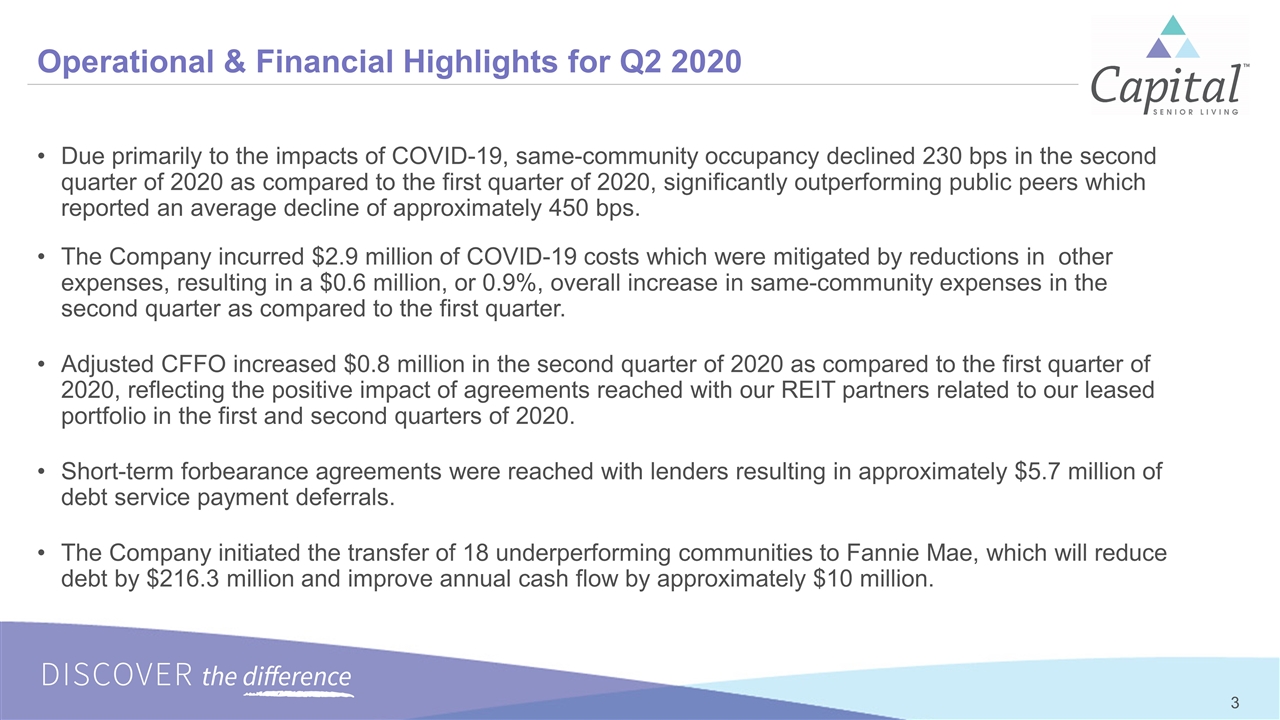
Operational & Financial Highlights for Q2 2020 Due primarily to the impacts of COVID-19, same-community occupancy declined 230 bps in the second quarter of 2020 as compared to the first quarter of 2020, significantly outperforming public peers which reported an average decline of approximately 450 bps. The Company incurred $2.9 million of COVID-19 costs which were mitigated by reductions in other expenses, resulting in a $0.6 million, or 0.9%, overall increase in same-community expenses in the second quarter as compared to the first quarter. Adjusted CFFO increased $0.8 million in the second quarter of 2020 as compared to the first quarter of 2020, reflecting the positive impact of agreements reached with our REIT partners related to our leased portfolio in the first and second quarters of 2020. Short-term forbearance agreements were reached with lenders resulting in approximately $5.7 million of debt service payment deferrals. The Company initiated the transfer of 18 underperforming communities to Fannie Mae, which will reduce debt by $216.3 million and improve annual cash flow by approximately $10 million.
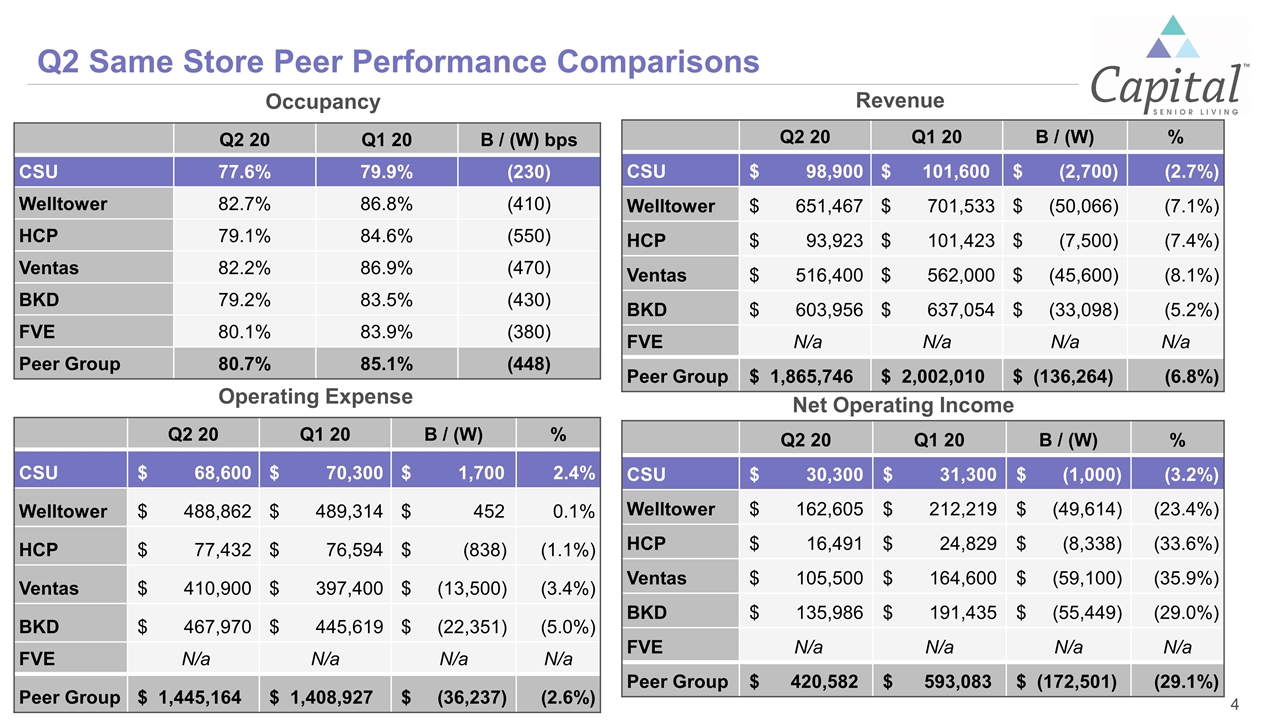
Q2 Same Store Peer Performance Comparisons Q2 20 Q1 20 B / (W) bps CSU 77.6% 79.9% (230) Welltower 82.7% 86.8% (410) HCP 79.1% 84.6% (550) Ventas 82.2% 86.9% (470) BKD 79.2% 83.5% (430) FVE 80.1% 83.9% (380) Peer Group 80.7% 85.1% (448) Occupancy Q2 20 Q1 20 B / (W) % CSU $ 30,300 $ 31,300 $ (1,000) (3.2%) Welltower $ 162,605 $ 212,219 $ (49,614) (23.4%) HCP $ 16,491 $ 24,829 $ (8,338) (33.6%) Ventas $ 105,500 $ 164,600 $ (59,100) (35.9%) BKD $ 135,986 $ 191,435 $ (55,449) (29.0%) FVE N/a N/a N/a N/a Peer Group $ 420,582 $ 593,083 $ (172,501) (29.1%) Net Operating Income Revenue Operating Expense Q2 20 Q1 20 B / (W) % CSU $ 68,600 $ 70,300 $ 1,700 2.4% Welltower $ 488,862 $ 489,314 $ 452 0.1% HCP $ 77,432 $ 76,594 $ (838) (1.1%) Ventas $ 410,900 $ 397,400 $ (13,500) (3.4%) BKD $ 467,970 $ 445,619 $ (22,351) (5.0%) FVE N/a N/a N/a N/a Peer Group $ 1,445,164 $ 1,408,927 $ (36,237) (2.6%) Q2 20 Q1 20 B / (W) % CSU $ 98,900 $ 101,600 $ (2,700) (2.7%) Welltower $ 651,467 $ 701,533 $ (50,066) (7.1%) HCP $ 93,923 $ 101,423 $ (7,500) (7.4%) Ventas $ 516,400 $ 562,000 $ (45,600) (8.1%) BKD $ 603,956 $ 637,054 $ (33,098) (5.2%) FVE N/a N/a N/a N/a Peer Group $ 1,865,746 $ 2,002,010 $ (136,264) (6.8%)
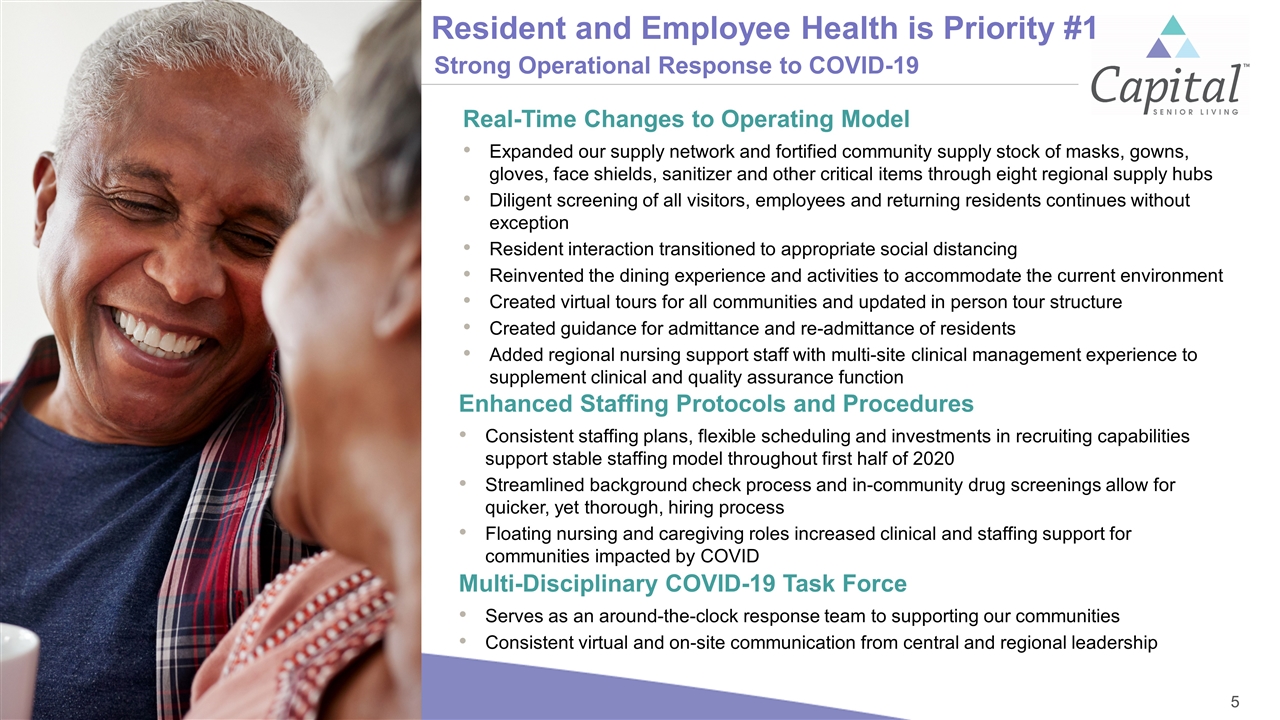
Resident and Employee Health is Priority #1 Real-Time Changes to Operating Model Expanded our supply network and fortified community supply stock of masks, gowns, gloves, face shields, sanitizer and other critical items through eight regional supply hubs Diligent screening of all visitors, employees and returning residents continues without exception Resident interaction transitioned to appropriate social distancing Reinvented the dining experience and activities to accommodate the current environment Created virtual tours for all communities and updated in person tour structure Created guidance for admittance and re-admittance of residents Added regional nursing support staff with multi-site clinical management experience to supplement clinical and quality assurance function Multi-Disciplinary COVID-19 Task Force Serves as an around-the-clock response team to supporting our communities Consistent virtual and on-site communication from central and regional leadership Enhanced Staffing Protocols and Procedures Consistent staffing plans, flexible scheduling and investments in recruiting capabilities support stable staffing model throughout first half of 2020 Streamlined background check process and in-community drug screenings allow for quicker, yet thorough, hiring process Floating nursing and caregiving roles increased clinical and staffing support for communities impacted by COVID Strong Operational Response to COVID-19
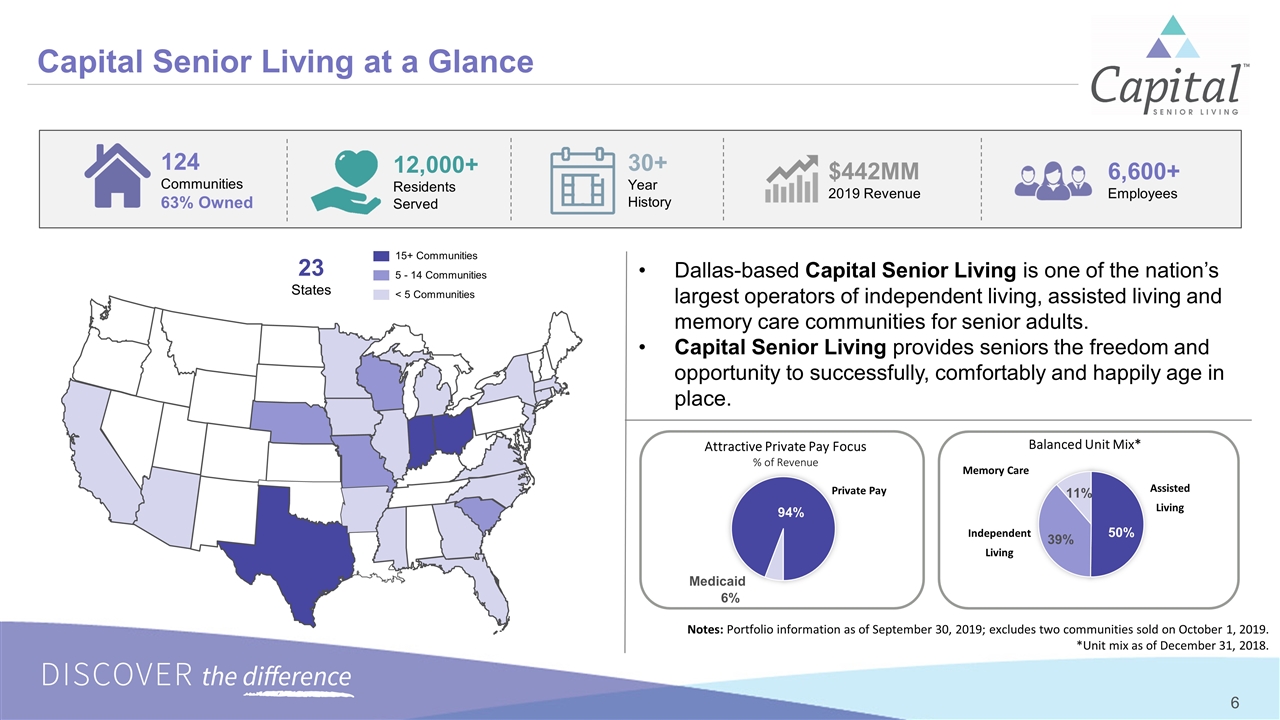
Capital Senior Living at a Glance Dallas-based Capital Senior Living is one of the nation’s largest operators of independent living, assisted living and memory care communities for senior adults. Capital Senior Living provides seniors the freedom and opportunity to successfully, comfortably and happily age in place. 15+ Communities 5 - 14 Communities < 5 Communities 23 States 124 Communities 63% Owned 12,000+ Residents Served 6,600+ Employees $442MM 2019 Revenue 30+ Year History Attractive Private Pay Focus % of Revenue Private Pay Balanced Unit Mix* Memory Care Independent Living Assisted Living Notes: Portfolio information as of September 30, 2019; excludes two communities sold on October 1, 2019. *Unit mix as of December 31, 2018.
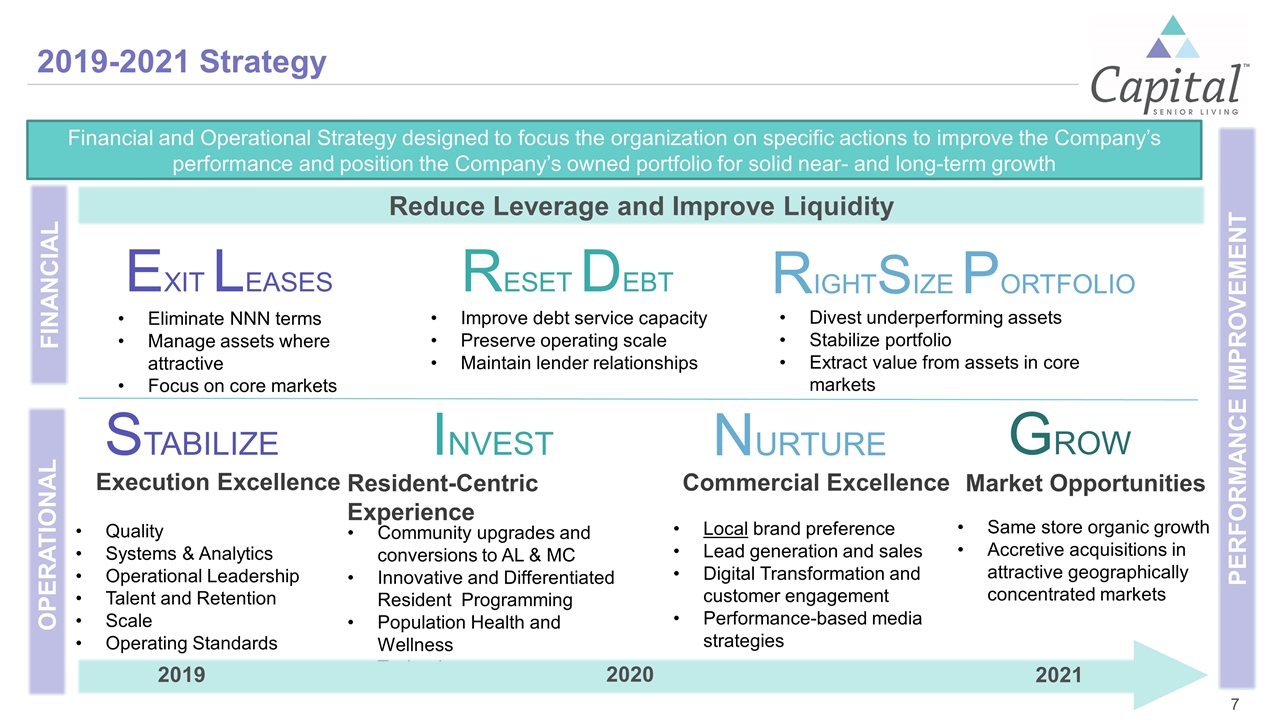
GROW 2019-2021 Strategy STABILIZE INVEST NURTURE Execution Excellence Resident-Centric Experience Commercial Excellence Market Opportunities Quality Systems & Analytics Operational Leadership Talent and Retention Scale Operating Standards Community upgrades and conversions to AL & MC Innovative and Differentiated Resident Programming Population Health and Wellness Technology Local brand preference Lead generation and sales Digital Transformation and customer engagement Performance-based media strategies Same store organic growth Accretive acquisitions in attractive geographically concentrated markets Strictly confidential 9 Reduce Leverage and Improve Liquidity OPERATIONAL FINANCIAL PERFORMANCE IMPROVEMENT EXIT LEASES RESET DEBT RIGHTSIZE PORTFOLIO 2019 2020 2021 Eliminate NNN terms Manage assets where attractive Focus on core markets Improve debt service capacity Preserve operating scale Maintain lender relationships Divest underperforming assets Stabilize portfolio Extract value from assets in core markets Financial and Operational Strategy designed to focus the organization on specific actions to improve the Company’s performance and position the Company’s owned portfolio for solid near- and long-term growth
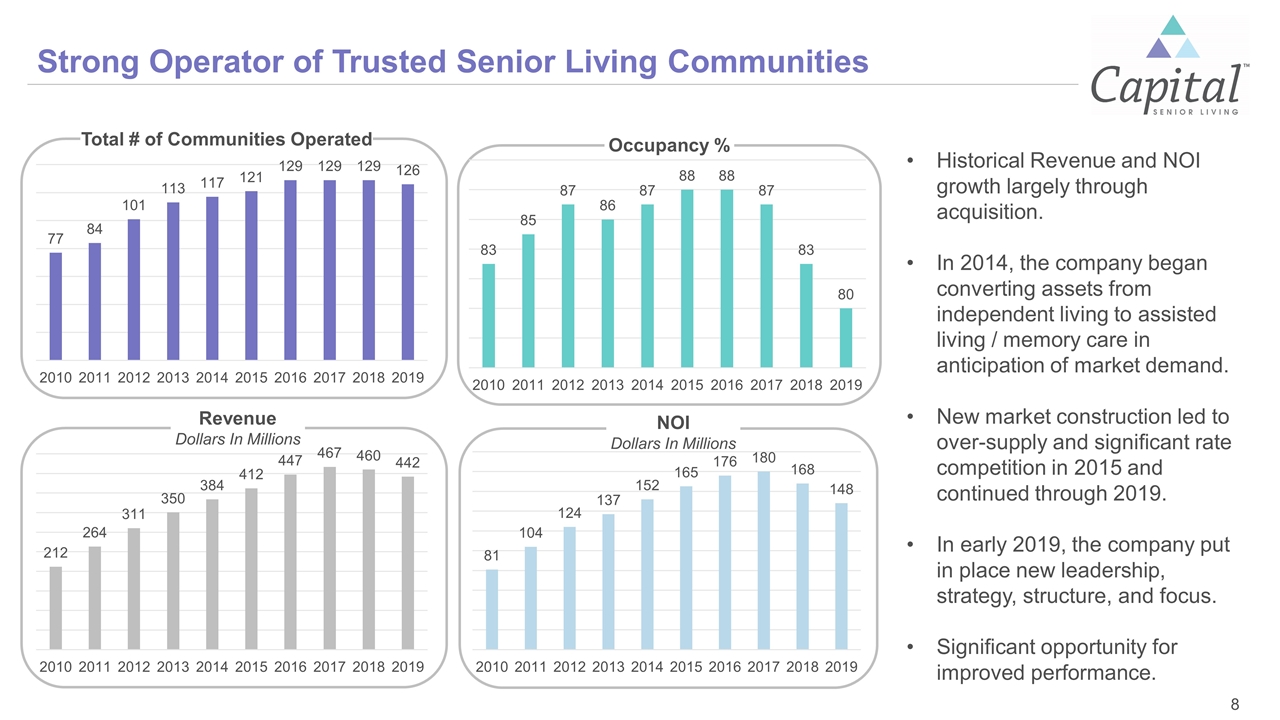
Strong Operator of Trusted Senior Living Communities Revenue Dollars In Millions Total # of Communities Operated NOI Dollars In Millions Historical Revenue and NOI growth largely through acquisition. In 2014, the company began converting assets from independent living to assisted living / memory care in anticipation of market demand. New market construction led to over-supply and significant rate competition in 2015 and continued through 2019. In early 2019, the company put in place new leadership, strategy, structure, and focus. Significant opportunity for improved performance. Occupancy %

Senior Housing Operators (by Units) CSU Enjoys Economies of Scale in a Highly-Fragmented Market During the last 18 months, as a “top ten” operator, Capital Senior Living has executed numerous operational upgrades to Implement broad operational best practices Establish portfolio-wide differentiated programing Use scale to achieve cost saving efficiencies Leverage marketing efforts particularly in competitive digital landscape Industry Mix by Level of Care (by Units) Source: NIC Investment Guide, Fifth Edition ©2019 National Investment Center for Seniors Housing & Care (NIC) Heavier mix of assisted living units at Capital Senior Living communities (50%) is aligned with growing market need. Approximately 1.6 million units are available in the US senior housing market. Source: ASHA 2019 Top 50, company filings and investor presentations.
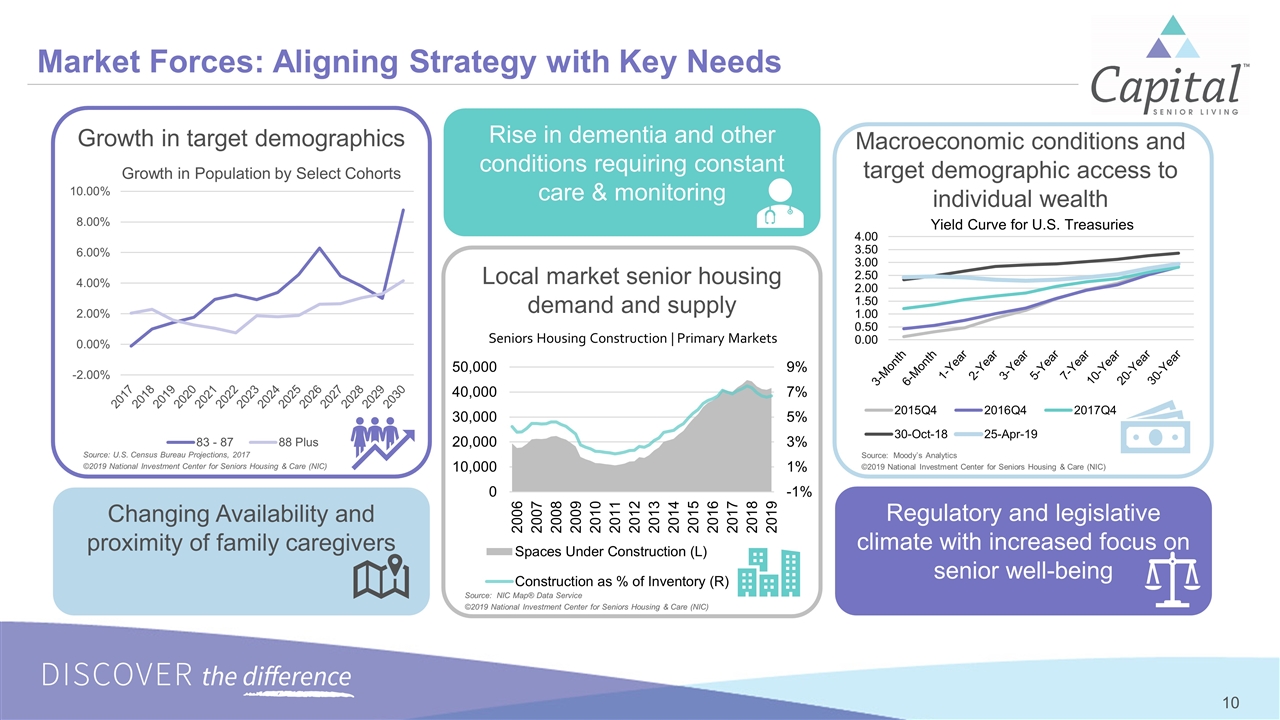
Market Forces: Aligning Strategy with Key Needs Rise in dementia and other conditions requiring constant care & monitoring Changing Availability and proximity of family caregivers Local market senior housing demand and supply Regulatory and legislative climate with increased focus on senior well-being Source: Moody’s Analytics ©2019 National Investment Center for Seniors Housing & Care (NIC) Growth in target demographics Source: U.S. Census Bureau Projections, 2017 ©2019 National Investment Center for Seniors Housing & Care (NIC) Source: NIC Map® Data Service ©2019 National Investment Center for Seniors Housing & Care (NIC) Macroeconomic conditions and target demographic access to individual wealth
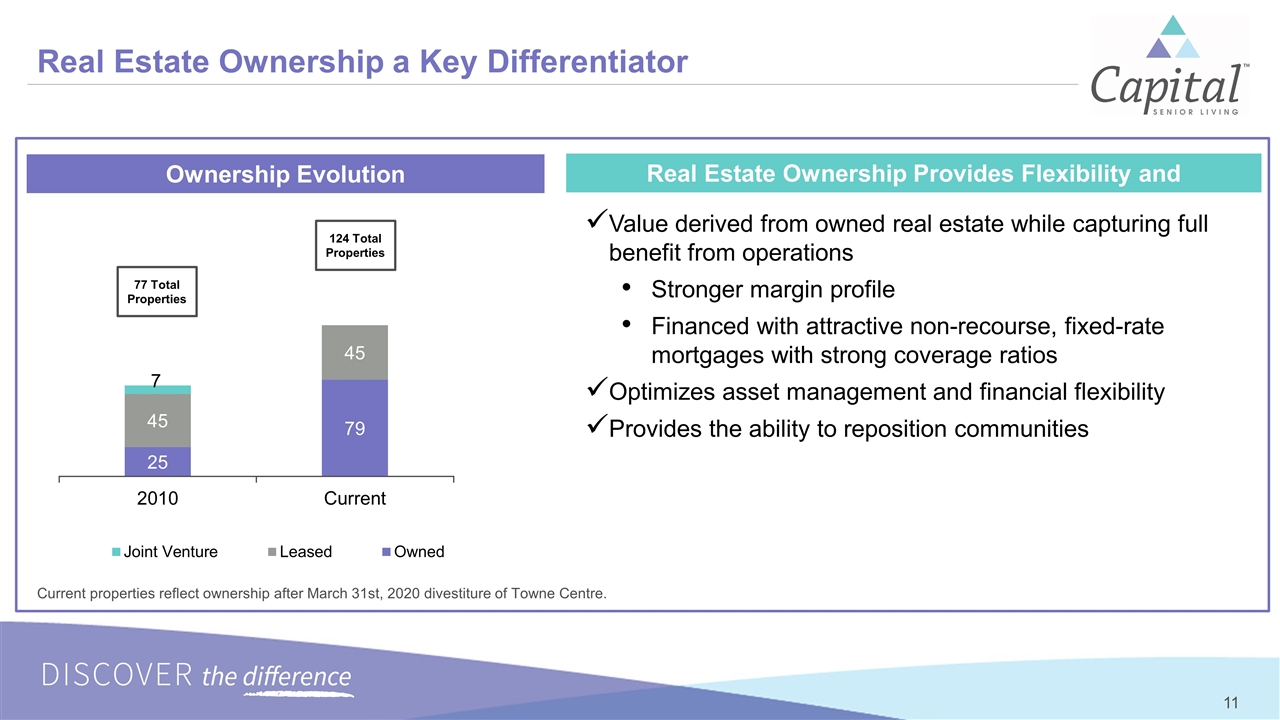
124 Total Properties 77 Total Properties Current properties reflect ownership after March 31st, 2020 divestiture of Towne Centre. Ownership Evolution Real Estate Ownership Provides Flexibility and Opportunities Value derived from owned real estate while capturing full benefit from operations Stronger margin profile Financed with attractive non-recourse, fixed-rate mortgages with strong coverage ratios Optimizes asset management and financial flexibility Provides the ability to reposition communities Real Estate Ownership a Key Differentiator
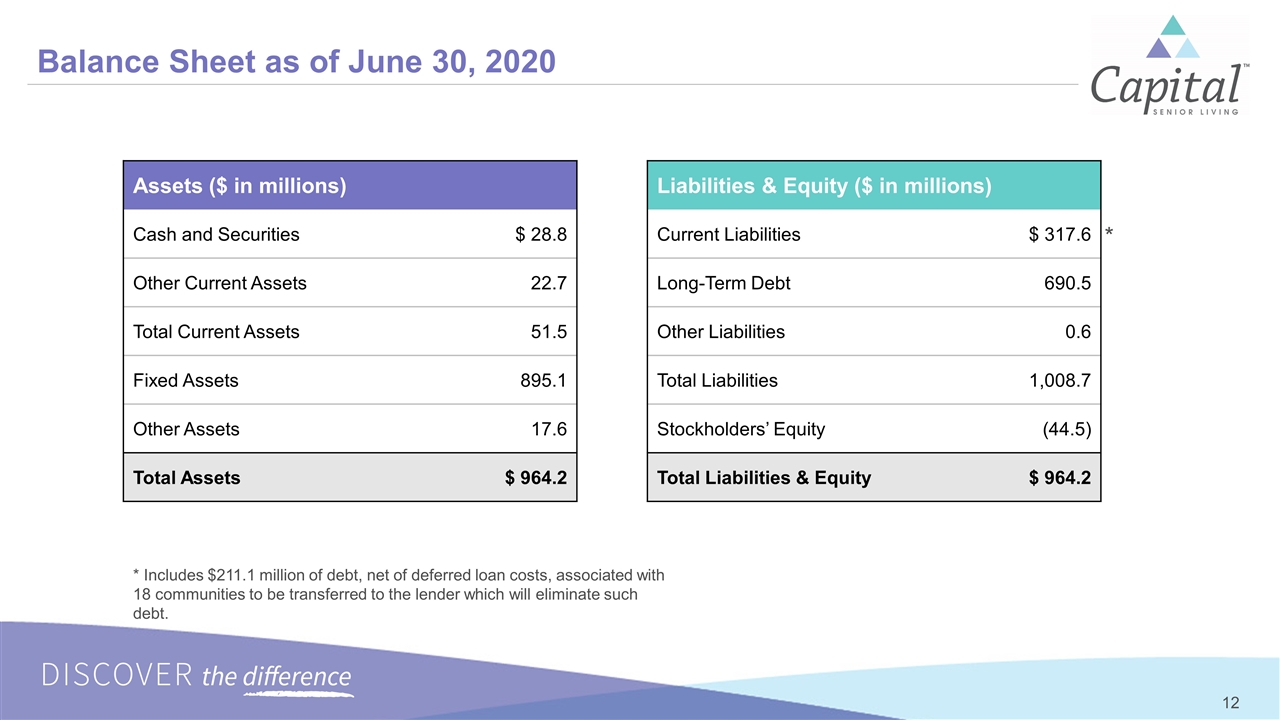
Balance Sheet as of June 30, 2020 Assets ($ in millions) Cash and Securities $ 28.8 Other Current Assets 22.7 Total Current Assets 51.5 Fixed Assets 895.1 Other Assets 17.6 Total Assets $ 964.2 Liabilities & Equity ($ in millions) Current Liabilities $ 317.6 Long-Term Debt 690.5 Other Liabilities 0.6 Total Liabilities 1,008.7 Stockholders’ Equity (44.5) Total Liabilities & Equity $ 964.2 * * Includes $211.1 million of debt, net of deferred loan costs, associated with 18 communities to be transferred to the lender which will eliminate such debt.
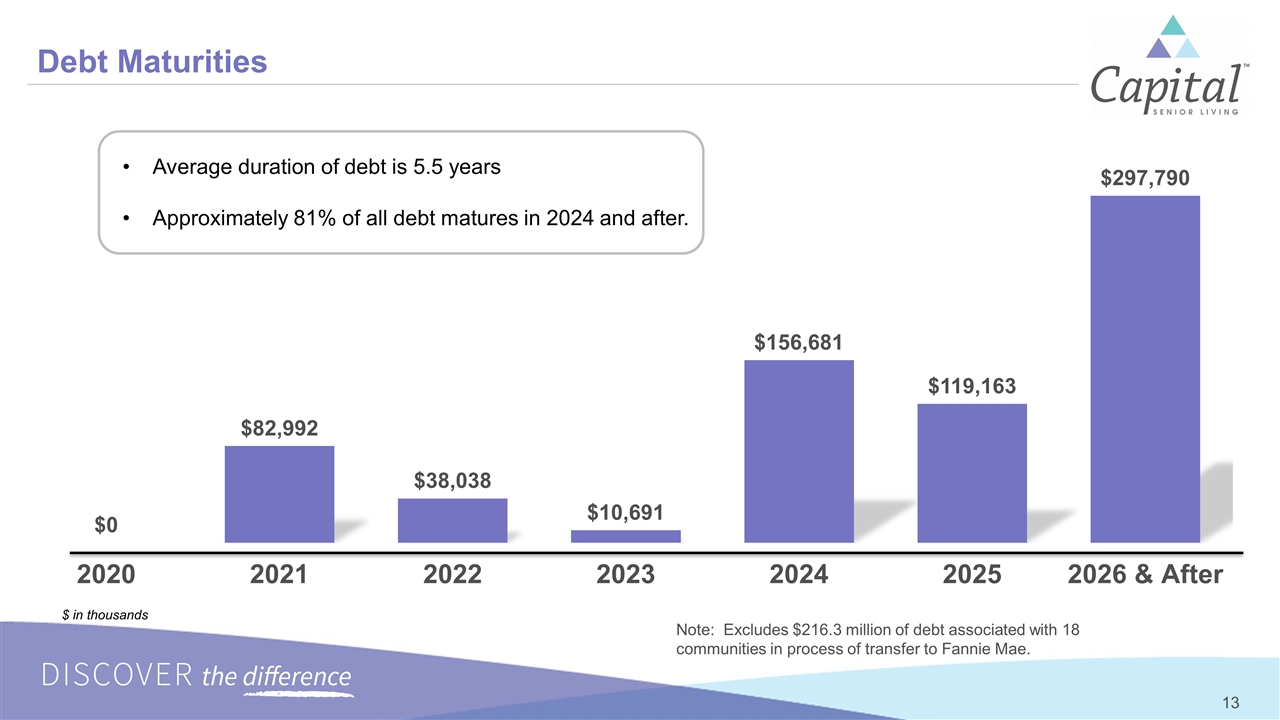
$ in thousands Debt Maturities Average duration of debt is 5.5 years Approximately 81% of all debt matures in 2024 and after. Note: Excludes $216.3 million of debt associated with 18 communities in process of transfer to Fannie Mae.

All NNN Leases Terminate On or Before 12/31/2020 124 Total Properties CSU Portfolio Current properties reflect ownership after March 31st, 2020 divestiture of Towne Centre. Master lease terminates on 12/31/20 Rent reduced to 75% of contractual rate effective 2/1/20 Ventas to reimburse Company for up to $1000/unit of capex until communities transition Communities will convert to management agreements if not transitioned by 12/31/20 Company releases security deposits held by Ventas Master leases terminate on 12/31/20 Rent reduced to 75% of contractual rate, net of reimbursed expenses, effective 2/1/20 Welltower to reimburse Company for up to $1000/unit of capex until communities transition Communities will convert to management agreements if not transitioned by 12/31/20 Company releases security deposits held by Welltower Master lease with 10/31/20 maturity date terminates on or before such date (one community transitioned on 1/15/20, others being marketed for sale by HP) Master lease with 4/30/26 maturity terminated and communities converted to interim management agreements effective 2/1/20 (communities being marketed for sale by HP) Company paid transition fee of $250k and releases security deposits held by Healthpeak When all transitions are complete, the Company’s cash flow will improve ~ $22.0M annually, and all related lease liabilities, which were ~ $253M at 12/31/19, will be eliminated.
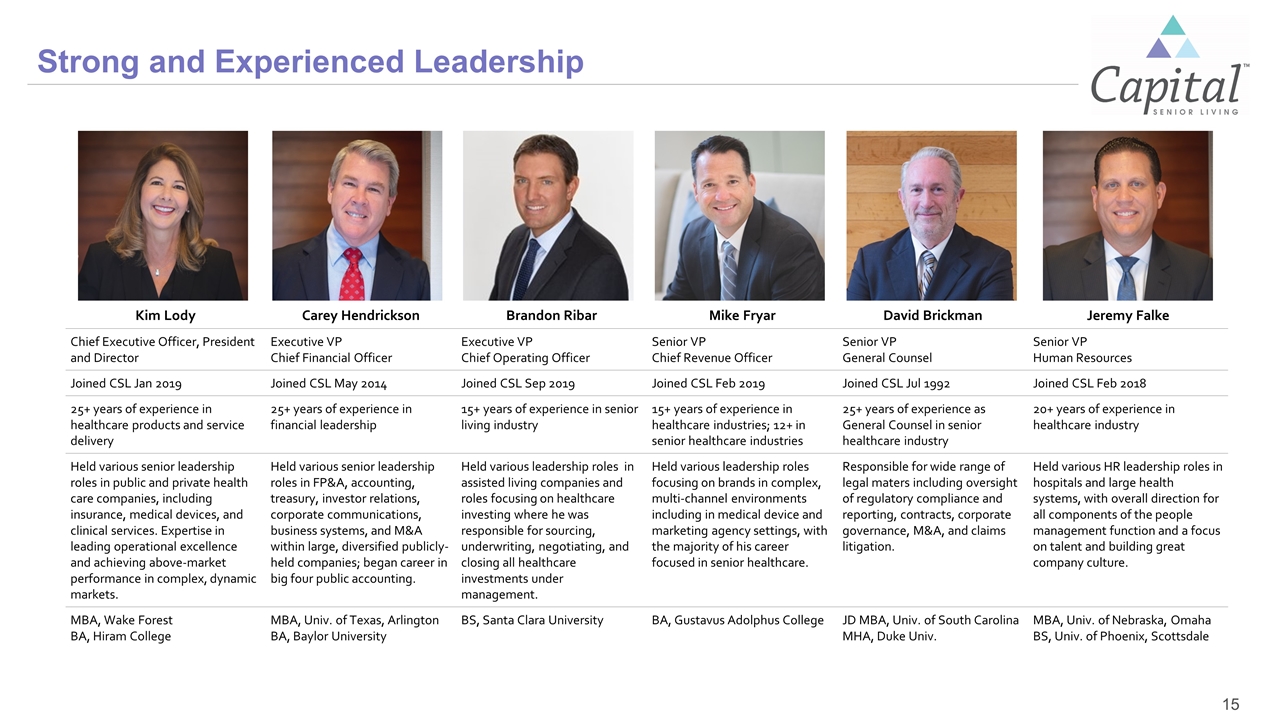
Strong and Experienced Leadership Kim Lody Carey Hendrickson Brandon Ribar Mike Fryar David Brickman Jeremy Falke Chief Executive Officer, President and Director Executive VP Chief Financial Officer Executive VP Chief Operating Officer Senior VP Chief Revenue Officer Senior VP General Counsel Senior VP Human Resources Joined CSL Jan 2019 Joined CSL May 2014 Joined CSL Sep 2019 Joined CSL Feb 2019 Joined CSL Jul 1992 Joined CSL Feb 2018 25+ years of experience in healthcare products and service delivery 25+ years of experience in financial leadership 15+ years of experience in senior living industry 15+ years of experience in healthcare industries; 12+ in senior healthcare industries 25+ years of experience as General Counsel in senior healthcare industry 20+ years of experience in healthcare industry Held various senior leadership roles in public and private health care companies, including insurance, medical devices, and clinical services. Expertise in leading operational excellence and achieving above-market performance in complex, dynamic markets. Held various senior leadership roles in FP&A, accounting, treasury, investor relations, corporate communications, business systems, and M&A within large, diversified publicly-held companies; began career in big four public accounting. Held various leadership roles in assisted living companies and roles focusing on healthcare investing where he was responsible for sourcing, underwriting, negotiating, and closing all healthcare investments under management. Held various leadership roles focusing on brands in complex, multi-channel environments including in medical device and marketing agency settings, with the majority of his career focused in senior healthcare. Responsible for wide range of legal maters including oversight of regulatory compliance and reporting, contracts, corporate governance, M&A, and claims litigation. Held various HR leadership roles in hospitals and large health systems, with overall direction for all components of the people management function and a focus on talent and building great company culture. MBA, Wake Forest BA, Hiram College MBA, Univ. of Texas, Arlington BA, Baylor University BS, Santa Clara University BA, Gustavus Adolphus College JD MBA, Univ. of South Carolina MHA, Duke Univ. MBA, Univ. of Nebraska, Omaha BS, Univ. of Phoenix, Scottsdale
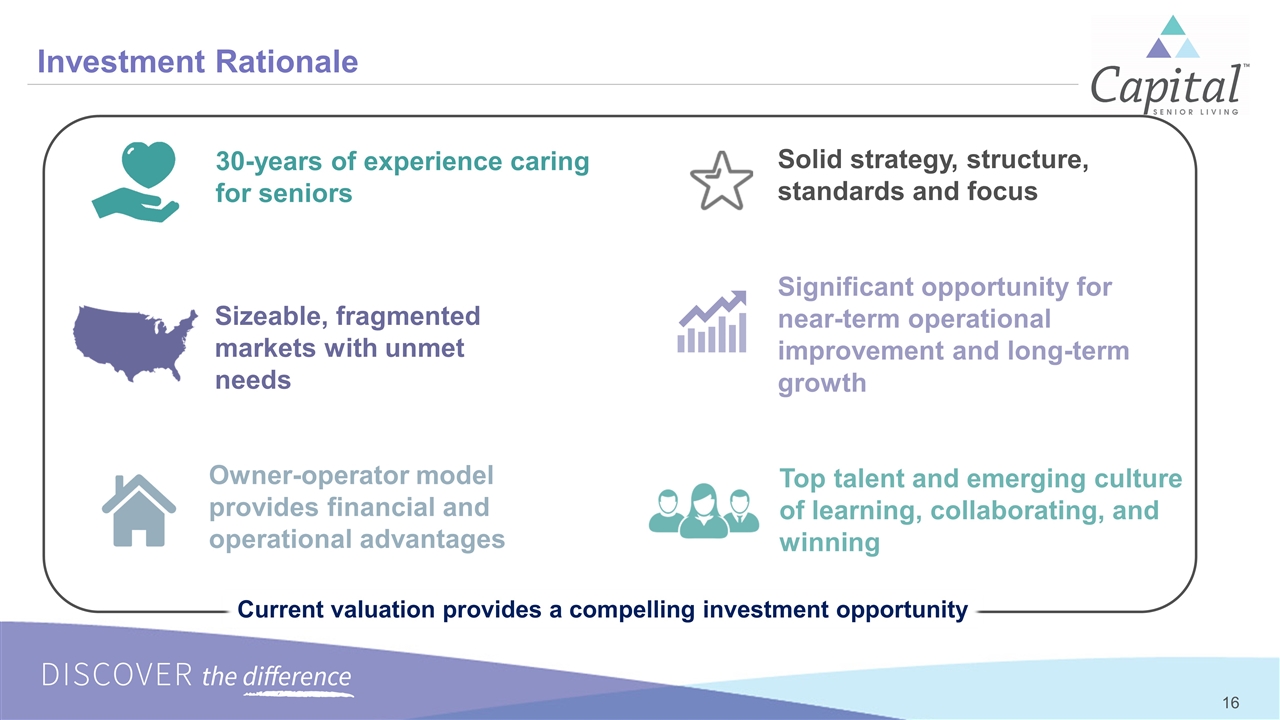
Investment Rationale Sizeable, fragmented markets with unmet needs Owner-operator model provides financial and operational advantages Top talent and emerging culture of learning, collaborating, and winning 30-years of experience caring for seniors Significant opportunity for near-term operational improvement and long-term growth Solid strategy, structure, standards and focus Current valuation provides a compelling investment opportunity
